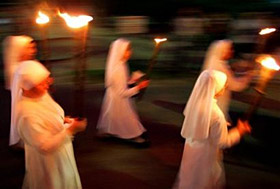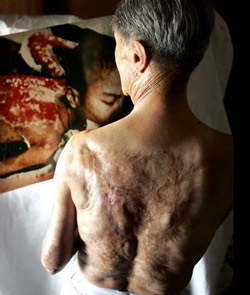Nagasaki Prepares for A-Bomb Anniversary
 Eric Talmadge - Associated Press Eric Talmadge - Associated Press


| | Roman Catholic nuns march during a torch parade at the 60th anniversary of the atomic bombing on Nagasaki, southwestern Japan Tuesday, Aug. 9, 2005. The atomic bomb attack on this city that left more than 80,000 dead and hastened the end of World War II exactly 60 years ago. (Photo: Itsuo Inouye) |
On the eve of the anniversary Tuesday of Nagasaki's devastation 60 years ago by the "Fat Man" atomic bomb, a steady stream of tourists flowed past the horrific exhibits at the city's memorial museum.

There is a clock, its glass smashed and bent hands frozen at exactly 11:02, the moment of the blast. There are photos, in black and white and in color, of the human toll. Chipped statues from a Catholic cathedral, once the largest in the Orient, line one wall.

But just a short walk away at Ground Zero, where a simple monolith stands in a small, dusty park, Ritsuko Yamasaki, offered a common lament.

"Our city is always in the shadow of Hiroshima," said Yamasaki, 70, who sells ice cream cones at the blast site. "Look at this. Tourists come here and ask me, `Where is the monument?' Hiroshima's is so much bigger. We need something like that, too."

Even Nagasaki's commemoration Tuesday will be a relatively quiet event.

Unlike Hiroshima, where more than 55,000 people crowded into Peace Memorial Park last week for a solemn memorial, officials here expect about 6,000 people to join in. The ceremony itself is almost the same — like Hiroshima, a moment of silence will be observed, followed by speeches from the mayor and Prime Minister Junichiro Koizumi.

On Monday, hundreds of labor union representatives staged a peace march through the city, and small gatherings were held to remember the dead. On each of the several cenotaphs — monuments for people whose remains are elsewhere — in and around Nagasaki's peace park were draped thousands of colorful paper cranes, which are believed to ease the pain of the dead.

Hojun Kubo, 79, said he comes to Nagasaki from his home in central Japan every year.

"I don't know anyone who died here," he said, after placing a string of cranes on Ground Zero. "But it was my generation that fought the war. Many of my friends died fighting. I come here because of that. It seems people forget about Nagasaki. I don't want that to happen."

Nagasaki's tragedy almost never happened.


| Sumiteru Taniguchi's back was severely burned by the atomic bomb "Fat Boy" on August 9, 1945. He is facing a photograph taken of him about six months after the bombing. (Photo: Yuriko Nakao / Reuters)

|
Three days after the Enola Gay dropped the "Little Boy" bomb on Hiroshima, killing at least 140,000 in the world's first atomic bomb attack, another bomber, Bock's Car, took off to deliver the second A-bomb.

It wasn't bound for Nagasaki, however.

Bock's Car's primary target was the nearby city of Kokura. But when it arrived, the city was hidden under a thick cover of smoke. The plane circled three times, then changed course for Nagasaki, where it also encountered thick clouds.

With dwindling fuel, the pilot nearly turned around — but then the clouds broke.

Roughly 80,000 people were killed by the blast or by related injuries or diseases in the months after.

"It's just mind-boggling that a single bomb could wipe out this city," tourist Naoto Otake said as he stood before a full-scale model of Fat Man at the museum. The bomb stood about 10 feet tall, and weighed 4.5 tons.

Other than the many small monuments around town, few signs of the devastation remain.

Today, Nagasaki, which has a population of about 420,000, has become a popular tourist destination, known for its Chinatown, one of the largest in Japan, and its vaguely European flair. |



